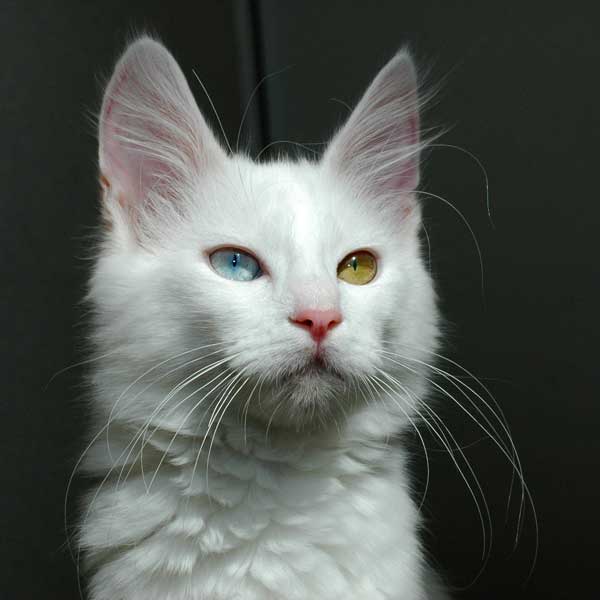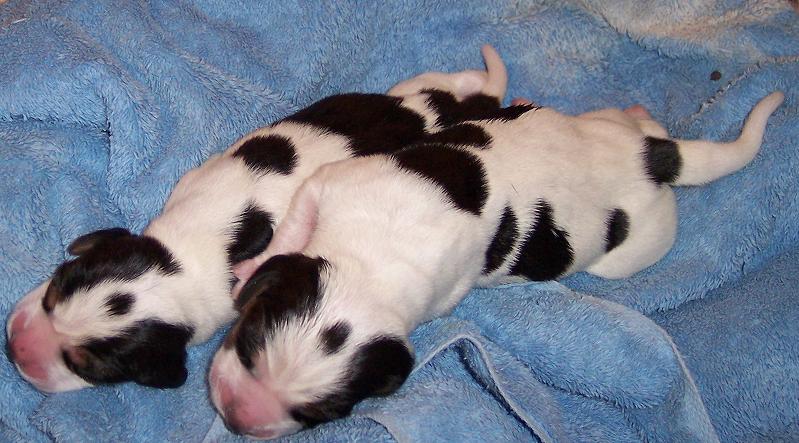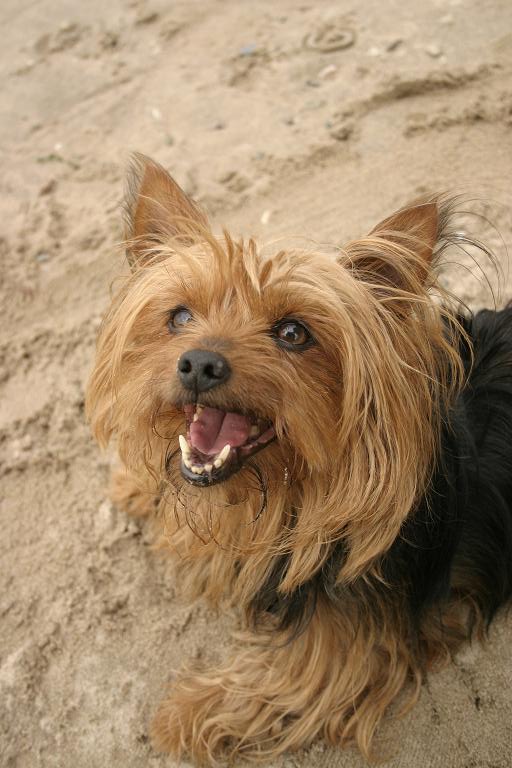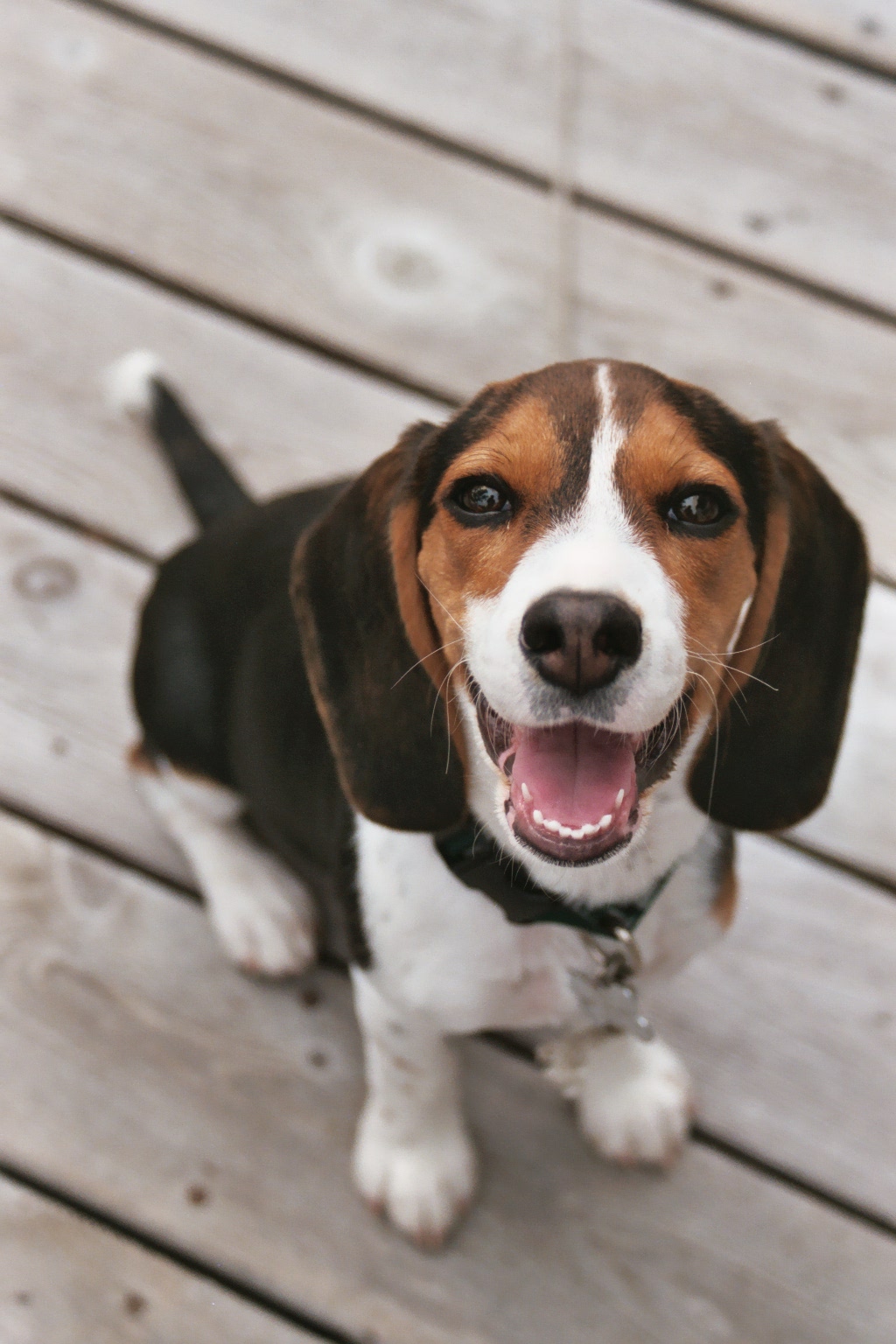Bones have long been associated with dogs. Just search Google Images for "dog with bone" and hundreds, if not thousands, of cartoon pictures of dogs with bones in their mouths will appear. Spock even has a tag in the shape of a little blue bone.
But should your really give your dog a bone? The short answer is "probably not". The main reason for this is that bones, especially chicken bones, splinter easily. Try breaking a small bone in half next time you eat chicken, and see how sharp it is!
The splinters of bone can literally cut open your dog's throat and intestines, to say nothing of the obvious choking hazard! And yes, it is possible for your dog to break a tooth on a bone. Bones are especially dangerous for large dogs.
The only time I would consider it safe to feed a bone to a dog is a RAW beef bone. Not a chicken bone. Not a cooked beef bone.
But even there, there are potential hazards. Experts and dog owners are still debating whether raw meat is safe for dogs. The time when Spock was most aggressive was while he was knowing a raw bone. It was frightening! That was the first- and the last- time that Spock got a real bone.
It is probably best to avoid giving your dog a bone to chew. Of course, any dog would love it, but if he never tries one, he won't know
what he's missing.
Showing posts with label dog. Show all posts
Showing posts with label dog. Show all posts
Friday, August 9, 2013
Thursday, August 8, 2013
Invisible Fences
Invisible dog fences might sound like a great idea. The UltraSmart® In-Ground Fence™ System by Petsafe®, for example costs $300 for 500 feet of "fence" wire. According to the "Red Beacon" website, 500 feet of chain-link fence would cost around $3500, and 500 feet of wooden fence would cost $9000!
Invisible fences work on a simple principal. When a dog, wearing a special collar, starts to cross the underground wire line, the dog gets a static shock. The shock is not dangerous, and the level can often be controlled.
Many dog owners and professionals discourage the use of these fences. Some of the reasons for this are listed below.
Invisible fences work on a simple principal. When a dog, wearing a special collar, starts to cross the underground wire line, the dog gets a static shock. The shock is not dangerous, and the level can often be controlled.
Many dog owners and professionals discourage the use of these fences. Some of the reasons for this are listed below.
- Some dogs will just decide to run over the wire, regardless of the shock. Some dogs might not understand that the wire is all over the yard, and run over the wire. After getting the shock, the dog may be too frightened to come back into the yard.
- If you take off your dog's collar and forget to put it back on, if the batteries wear out, or if the line goes dead, the electric fence obviously has no effect.
- Stray dogs can still enter a yard with invisible fencing.
- An invisible fence offers no protection against theft for your dog.
Tuesday, May 28, 2013
Answers to the Quiz
- German Shepherds
- Boxer
- Dalmatians (yep, they are born without spots!)
- Rottweiler
- Newfoundland
- Neopolitan Mastiffs
- Border Collie
- Beagles
- Collie
- Greyhound
Sunday, January 20, 2013
Pictures of Spock!
 |
| Look at those legs! |
 |
| Sleeping puppy! So cute! |
 |
| Attacking 'Belinda' the rubber chicken. |
 |
| Yum! |
 |
| Looking like a German Shepard |
 |
| Isn't this an adorable puppy!? |
 |
| Spock wearing a hat I crocheted. |
 |
| Yawning puppy. |
Friday, December 7, 2012
Giving Spock a Shot
To save big dollars (as I wrote about in my post 'What Your Vet Doesn't Want You to Know') we gave Spock a puppy shot at home.
Dad did it, because he gave piglets shots as a kid, and it's probably done the same as on puppies.
It was quick and pretty easy, though Spock did squirm and yelp. We are planning on giving him his next shot (and last puppy shot other then rabies) at home as well.
Dad did it, because he gave piglets shots as a kid, and it's probably done the same as on puppies.
It was quick and pretty easy, though Spock did squirm and yelp. We are planning on giving him his next shot (and last puppy shot other then rabies) at home as well.
Thursday, November 29, 2012
More Spock Pictures
Spock's been doing really well. We got him some new toys today, and he loves them. He also loves playing outside. Today we discovered that he is very much a runt. Instead of 9 pounds, the normal weight for an 9 week old corgi pup, he weighs exactly 4 pounds. This is not unheard of the corgi world. Anyway, here are some more pictures!
 |
| Note: his eyes are not that color! |
Saturday, November 24, 2012
Meet Spock
Mr. Spock is our latest pet. He is a puppy! He got his name from his ears, which, though tiny now, will eventually be very large and stick up. A Pembroke Welsh Corgi puppy, to be exact. Some friends of ours knew of someone giving away puppies, and they took one and we took the other. Spock is so cute! He is very quiet (except for whining a lot in the car), sleeps a lot, and is extremely calm.
Mom and Dad planned for Spock to be an outdoor dog, but a puppy this small (8 weeks old!) would probably not be able to keep warm, and he would be able to squeeze under the fence. Thus, Spock is now asleep in my bedroom :)
I have never seen a more mild mannered puppy then Spock, and he seems like he'll be a great pet.
 |
| This is a picture of him. The picture does not do him justice! He is soooo much cuter in real life! |
I have never seen a more mild mannered puppy then Spock, and he seems like he'll be a great pet.
Saturday, October 27, 2012
Odd-eyed Pets
 |
| This is a Husky, one of the most common dogs with odd-eyes. |
Heterochromia Iridum, commonly called odd-eyed, causes eyes to be different colors, is very rare in humans but more common in animals.
In dogs, certain breeds are more often to be odd-eyed then others. The three most commonly odd eyed dogs are Huskies, Australian Shepherd, and Catahoula Leopard Dogs. It is also seen in various other dogs, herding dogs, Great Danes, Chihuahuas, and some others.
With cats, Heterochromia Iridum is found virtually exclusively in the white ones. There is, in odd-eyed cats, a connection between deafness, and the odd-eyes. 30%- 40% of odd-eyed cats are deaf.
Odd-eyed dogs and cats make just as good pets as nomal eyed pets, although they are deaf sometimes.
In dogs, certain breeds are more often to be odd-eyed then others. The three most commonly odd eyed dogs are Huskies, Australian Shepherd, and Catahoula Leopard Dogs. It is also seen in various other dogs, herding dogs, Great Danes, Chihuahuas, and some others.
With cats, Heterochromia Iridum is found virtually exclusively in the white ones. There is, in odd-eyed cats, a connection between deafness, and the odd-eyes. 30%- 40% of odd-eyed cats are deaf.
 |
| A Turkish Angora breed cat displaying Heterochromia Iridum. |
Monday, October 15, 2012
Boston Terrier
Although the Boston Terrier is, of course, a terrier, these aren't in the terrier group, instead, they are classified in the non-sporting group.
Boston Terriers have their roots in fighting dogs, but now they are friendly, lovable pets.
Bostons are small to medium sized dogs, ranging in size from 10 - 25 pounds.
One big problem with these dogs is the many health problems these dogs have. Being brachycephalic (having "smushed in" faces), this breed is prone to breathing problems, sensitive digestive system, heart murmer, they are prone to deafness, and most dogs of this breed have trouble giving birth.
Bostons are sweet, intelligent dogs, and if you are able to cope with possible health problems, these can be quite fun pets.
Boston Terriers have their roots in fighting dogs, but now they are friendly, lovable pets.
Bostons are small to medium sized dogs, ranging in size from 10 - 25 pounds.
One big problem with these dogs is the many health problems these dogs have. Being brachycephalic (having "smushed in" faces), this breed is prone to breathing problems, sensitive digestive system, heart murmer, they are prone to deafness, and most dogs of this breed have trouble giving birth.
Bostons are sweet, intelligent dogs, and if you are able to cope with possible health problems, these can be quite fun pets.
 |
| puppy |
 |
| adult |
Wednesday, October 10, 2012
Yorkies
Yorkies are very popular pets, ranking 5 out of 173 on the AKC dog registration statistics. They are small, (but most owners says they "act like big dogs"), cute, and readily available.
They are one of the breeds most suited for indoor living, as they have hair, not fur! They don't shed, unless they have a skin problem. Yorkies do need to visit a groomer, to either groom long fur or clip it, but the low cost of dog food for this breed makes up for it.
In the area of intelligence, they are considered, "above average" at #27.
Although they are terriers, Yorkies are not in the terrier group, and have a different personality than larger terriers, like Russels, Rats, and Pitbulls.
A man in our church has sometimes brought a Yorkie, Baxter, to our house. Notably, Baxter is the only dog that's been in our house since we moved in. He is very sweet, and from what I have seen of him, he is a quite and well behaved dog.
If you are looking for a small, lovable dog, and are willing to take care of the a dog with high grooming requirements, a Yorkie might be the right dog for you,
They are one of the breeds most suited for indoor living, as they have hair, not fur! They don't shed, unless they have a skin problem. Yorkies do need to visit a groomer, to either groom long fur or clip it, but the low cost of dog food for this breed makes up for it.
In the area of intelligence, they are considered, "above average" at #27.
Although they are terriers, Yorkies are not in the terrier group, and have a different personality than larger terriers, like Russels, Rats, and Pitbulls.
A man in our church has sometimes brought a Yorkie, Baxter, to our house. Notably, Baxter is the only dog that's been in our house since we moved in. He is very sweet, and from what I have seen of him, he is a quite and well behaved dog.
If you are looking for a small, lovable dog, and are willing to take care of the a dog with high grooming requirements, a Yorkie might be the right dog for you,
Saturday, August 4, 2012
Are Puppies Bad Pets?
I read another article on the dog channel website. Million Dollars= Puppy
Basically, the article says adult dogs are great, rescue dogs are better, puppies are horrible. Consider these quotes from the article.
"When I see an adult dog that needs a home, I think, 'There’s someone’s best friend. He just needs a chance'... When I see a puppy that needs a home.... I think.... 'just put your shoes, cell phones, throw pillows, and other loose
valuables into a box, walk down to the closest body of water, and toss
it all in.'"
"Puppies have little personality. They are blobs of fur with big eyes"
"An adult dog is thrilled beyond words to get out of the shelter and into
a warm home – his gratitude is boundless. If you don’t believe it,
adopt an abused or neglected dog from the shelter and watch him blossom.
A puppy? Clueless."
"Whenever someone announces, excitedly, 'I’m getting a puppy!' I actually groan."
Not surprisingly, the author goes on to say, 'I’ve adopted all of my dogs as young adults, except for one stray senior dog... I won't adopt any dog younger than two years old'. How could you say such things about puppies if you haven't even owned a puppy?
Here are some ways to keep your house from being destroyed by a puppy.
- Keep anything valuable totally away from the puppy
- Keep small things, like shoes, away from the puppy
- Don't let the puppy the carpet until he is fully housebroken
- Train the puppy not to chew on anything but chew toys. Clicker training works well for this.
Yes, puppies are more work than adult dogs, but if you want a puppy and can care for and train a puppy, then go for it.
Tuesday, July 31, 2012
Pets I've Met: Wookie
Wookie is a cute little dog owned by my cousin. He is half Bichon Frise and half Shih Tzu, making him a loveable mix know as a Teddy Bear Dog.
Wookie was adopted by my cousin when he was already six years old, so he is seven or eight years old now.
Wookie is a talented little dog. He can do a lot of tricks and he is learning to do Agility.
An interesting thing about Wookie is that one of his favorite treats is.... lettuce! He'll do anything for a nice piece of it!
Oh, and yes, he is named after Star Wars Wookies.
 |
| Wookie looks sort of like a puppy in this shot, but in reality he is middle-aged. |
Wookie was adopted by my cousin when he was already six years old, so he is seven or eight years old now.
 |
| A close up shot of Wookie. |
Wookie is a talented little dog. He can do a lot of tricks and he is learning to do Agility.
An interesting thing about Wookie is that one of his favorite treats is.... lettuce! He'll do anything for a nice piece of it!
Oh, and yes, he is named after Star Wars Wookies.
Tuesday, July 17, 2012
What Your Vet Won't Tell You- Shots At Home!
Dogs and Cats don't enjoy trips to the vet. It is often stressful for them. Also, shots at a vet's are expensive. giving your dog or cat vaccines at home is less stressful for you and your pet, saves you plenty of money, and is a lot less hassle than taking your pet to a vet.
It will cost an average of $150 for shots for a puppy. Getting the shots online (Drs. Foster and Smith is one good vaccine seller), would cost closer to $15 (not counting the Rabies shot, you have to go to a vet for that).
For a kitten, Vet Shots will cost about $100. At home shots- about $10 (again, not counting rabies).
The Drs. Foster and Smith website has videos and instructions on how to vaccinate cats and dogs. It is quite easy, but you do have to be careful.
It will cost an average of $150 for shots for a puppy. Getting the shots online (Drs. Foster and Smith is one good vaccine seller), would cost closer to $15 (not counting the Rabies shot, you have to go to a vet for that).
For a kitten, Vet Shots will cost about $100. At home shots- about $10 (again, not counting rabies).
The Drs. Foster and Smith website has videos and instructions on how to vaccinate cats and dogs. It is quite easy, but you do have to be careful.
Labels:
cat,
dog,
kitten,
puppy,
save money,
vaccination
Saturday, July 14, 2012
How to deal with dog and cat fur
Ask anyone who has an indoor dog or cat what the worst part of keeping their pet indoors is, and they will most likely say "the shedding."
So, if you have an indoor dog or cat, how do you deal with all that fur? By the way, in case you haven't guessed, if you have a non-shedding breed, this post won't be very useful for you.
You want to be able for someone to walk into your house, sit down, and not know that you have a dog or cat before they see the pet itself! This is possible, with some work.
Here are some things that you can do:
On the pet:
Buy a FURminator grooming tool. These de-shedding tools, really do remove hair. There is a video on the site, and a 4.6 out of 5 star rating on Amazon.com to show it. FURminator claims that the tools will not only remove the dead fur before it gets all over, but it reduces shedding to up to 90%. One Amazon.com review said that it got a grocery bag full or fur off of their two Goldens. Wow! A grocery bag full less fur around the house. There is one draw back: namely, the price! The newest model of de-shedding tool for medium sized, long haired dogs costs- $54! A tool for a small, long haired cat isn't much less- $44. Amazon has the tools for as little as $15, so if you want to save, don't buy off the website!
Vaccuming your pet: You may have read about doing this in the book "Ramona's World." I does work, on both cats and dogs, though it might take some training to get them to accept it. It will not hurt the pet, but they might find it a bit uncomfortable before they get used to it. Use the upholstery attachment.
On Furniture
Train your pet to stay off the furniture: It's no harder than teaching your pet to stop doing anything else.
If you don't mind having a pet on the furniture, try the wet rubber glove method: It's just what it sounds like: get a
bucket of water and a rubber glove. Put the glove on, dip it in the
bucket, and rub your gloved hand on a furry couch or chair. Dip the
glove again to rinse it, and repeat.
Or, use a cover: Put a slip-cover or sheet over the couch. Then, just wash it when it gets too furry. Wash it with out any thing else in the washing machine! You can take it off when company is coming. Just keep your pet away when the cover is off.
On Carpet
Squirt the carpet before you vacuum: Mix a couple squirts of fabric softener with lukewarm water in a spray bottle. Then, shake and squirt. Don't get the carpet too wet, and let it dry before you vacuum. This will make it easier to vaccum up the fur.
Baking soda: Sprinkle this around before you vacuum. This makes it easier to vacuum all the fur, and will also make the room smell better.
On Hardwood Floor and Tile
Sponge it: Try using a barely damped kitchen sponge on the floor. This will clump up the hair, and make it easier to clean up. Sweeping will only make it worse, as the fur will go all over- not something you want to happen in your kitchen!
Swivel Sweeper: This is kind of a cross between a broom and a vacuum, and will work moderately well on pet hair.
I hope those tips were helpful.
Thursday, July 12, 2012
What sort of dogs are good with young children?
Dogs and kids seem just meant for each other, but some dogs are better for kids than others. You want a dog that can play a little bit rough, will tolerate things such as ear and tail pulling without biting, and not be so huge that he will knock the child over during play.
Some dogs that are great for kids are: Boxer, Pitbull, any of the Retrievers, Standard and Mini Poodle (not toy), Pug (the best of the toy dogs for children), Bulldog, Herding Dogs (though the smaller ones, like Shelties and Corgis might nip if aggravated), Bichon Frise, Labra/Goldendoodle and Boston Terrier.
With mixed breed dogs, you can't always tell what the dog will be like with children. You need to bring your children with you when you go to look at a dog to see how they react.
Remember, individual dogs will have different personalities.
Some dogs that are great for kids are: Boxer, Pitbull, any of the Retrievers, Standard and Mini Poodle (not toy), Pug (the best of the toy dogs for children), Bulldog, Herding Dogs (though the smaller ones, like Shelties and Corgis might nip if aggravated), Bichon Frise, Labra/Goldendoodle and Boston Terrier.
With mixed breed dogs, you can't always tell what the dog will be like with children. You need to bring your children with you when you go to look at a dog to see how they react.
Remember, individual dogs will have different personalities.
Thursday, June 21, 2012
Beagle
| A "pocket" beagle. |
Small and lovable hounds, Beagles are far more active than Snoopy. Though often considered dumb, the truth is that they aren't as intelligent as some dogs like Border Collies, Shelties, and Poodles, but the are far from dumb. They are just a little harder to train then most dogs.
 | ||
| A resting beagle. |
Beagle puppies are so cute that I decided to have several pictures of them.
 |
| These puppies aren't even two days old. |
| Six weeks old. |
This young beagle sure looks happy!
Beagle are designed to be outdoor dogs. If they spend a lot of time indoors, they tend to get fat. Another thing to be aware of is that Beagles will run away if they get a chance.
If you are able to spend extra time training your dog, a Beagle might be a good pet for you.
Subscribe to:
Posts (Atom)



